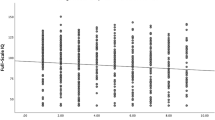Abstract
A study is presented with a focus on IQ measurements of subnormal and autistic children analyzed for repeatability and also for relationship to other factors such as severity of illness and outcome of treatment. Initial IQ measurements correlated well with those obtained c. 5 years later (M=5.32). Of the 115 autistic children tested, 94% had General IQs in the retarded range (< 68) at initial evaluation. IQ estimates were significantly related to the severity of symptoms and effectively predicted performance at school. Children with IQ > 50 at initial evaluation, who were subsequently treated, showed a greater increase in IQ than untreated children in the same IQ range. Treatment was without differential effect for children with < 40 IQs. After treatment, Verbal IQ gains tended to be maintained or improved in groups with higher initial IQs, but stagnated or were even lost in the lower IQ groups.
Similar content being viewed by others
References
Alpern, G. D. Measurement of “untestable” autistic children.Journal of Abnormal Psychology, 1967,72(6), 478–486.
Alpern, G. D., & Kimberlin, C. C. Short intelligence test ranging from infancy levels through childhood levels for use with the retarded.American Journal of Mental Deficiencies, 1970,75(1), 65–71.
DeMyer, M. K., Barton, S., & Norton, J. A. A comparison of adaptive, verbal, and motor profiles of psychotic and nonpsychotic subnormal children.Journal of Autism and Childhood Schizophrenia, 1972,2, 359–377.
DeMyer, M. K., Barton, S., DeMyer, W. E., Norton, J. A., Allen, J., & Steele, R. Prognosis in autism: A follow-up study.Journal of Autism and Childhood Schizophrenia, 1973,3, 199–246.
DeMyer, M. K., Norton, J. A., & Barton, S. Social and adaptive behaviors of autistic children as measured in a structured psychiatric interview. In D. W. Churchill, G. D. Alpern, & M. K. DeMyer (Eds.),Infantile autism: Proceedings of Indiana University Colloquium. Springfield, Ill.: Charles C Thomas, 1971.
Gesell, A., & Amatruda, C.Developmental diagnosis. New York: Paul B. Hoeber, 1951.
Hingtgen, J., & Bryson, C. Recent developments in the study of early childhood schizophrenia and related disorders.Schizophrenia Bulletin, 1972,5, 8–54.
Honzik, M., Macfarlane, J., & Allen, L. The stability of mental test performance between two and eighteen years.Journal of Experimental Education, 1948,17, 309–324.
McCarthy, D. Language development in children. In L. Carmichael (Ed.),Manual of child psychology. (2nd ed.) New York: Wiley & Sons, 1954.
Rutter, M., & Lockyer, L. A five to fifteen year follow-up study of infantile psychosis. I. Description of the sample.British Journal of Psychiatry, 1967,113, 1169–1182.
Sheridan, M.The developmental progress of infants and young children: Ministry of Health reports on public health and medical subjects. London: Her Majesty's Stationery Office, 1960 (No. 102).
Author information
Authors and Affiliations
Additional information
This study was supported in part by Public Health Service Grant MH05154 and also by LaRue D. Carter Memorial Hospital, State of Indiana, Indianapolis, Indiana.
Rights and permissions
About this article
Cite this article
DeMyer, M.K., Barton, S., Alpern, G.D. et al. The measured intelligence of autistic children. J Autism Dev Disord 4, 42–60 (1974). https://doi.org/10.1007/BF02104999
Issue Date:
DOI: https://doi.org/10.1007/BF02104999




